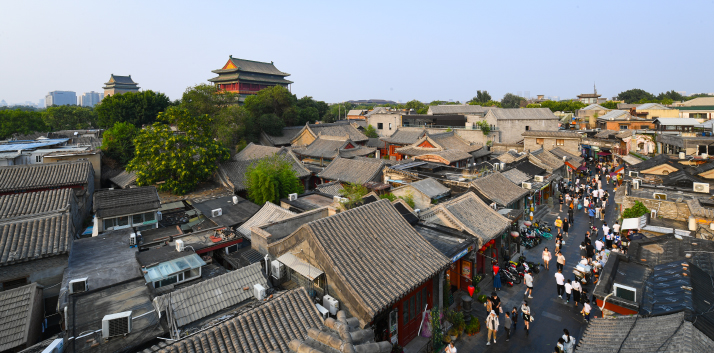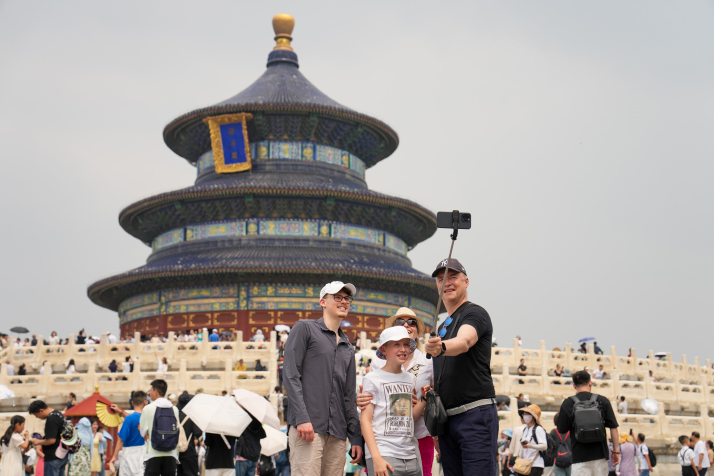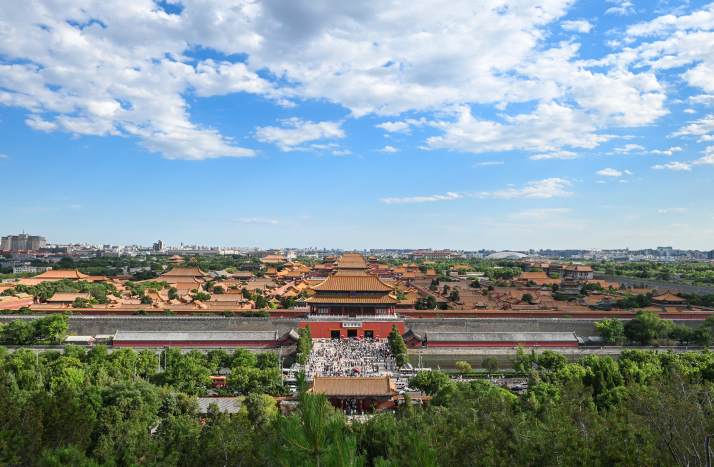| China |
| Transforming Beijing's historic lifeline into living heritage | |
|
|
 A distant view of the Bell and Drum Towers in Beijing on July 10 (XINHUA)
The term "Beijing Central Axis" might not immediately resonate with many readers, but the iconic landmarks that adorn this line, including the Forbidden City, the Temple of Heaven, and Tiananmen Square, are undoubtedly familiar to many. Stretching 7.8 km from the Bell and Drum Towers in the north to the Yongding Gate in the south, the Central Axis lies at the very heart of Beijing. Its construction began in the 13th century during the Yuan Dynasty (1271-1368) when Beijing was first established as the capital of China. Originally less than 5 km long, the Axis was extended by several emperors during the following Ming and Qing dynasties (1368-1911), reaching its current length of 7.8 km by the 16th century. Refined continuously over seven centuries, the Beijing Central Axis remains in use today and stands as the longest and best-preserved imperial city axis in the world. It is an urban architectural complex that includes imperial palaces and gardens, ancient urban management facilities, national ceremonial and public buildings, and roads. On July 27, at the 46th session of the UNESCO World Heritage Committee, held in New Delhi of India, the Beijing Central Axis was honored with inclusion on the UNESCO World Heritage List as "A Building Ensemble Exhibiting the Ideal Order of the Chinese Capital." This recognition established it as China's 59th World Heritage site. Connecting past with present Born in 1989 in a traditional hutong alleyway near Wanning Bridge on the Beijing Central Axis, Song Zhuangzhuang, a designer in Beijing, has been fascinated with the urban design of the capital since middle school. He frequently visits archives to gather research materials and his academic journey has led him to earn a bachelor's degree from Tsinghua University's Department of Architecture and a master's degree from the Harvard University Graduate School of Design. "The first time I encountered the concept of the Beijing Central Axis was during a course on the history of ancient Chinese architecture at Tsinghua," Song told People's Pictorial magazine. "It was a paradigm shift for me. I began to view the space I had always inhabited as a subject for study and research." "The Beijing Central Axis boasts a history that spans more than 700 years, a duration that is exceptionally rare on a global scale," he said. The urban planning principle of orienting a city's core along a central axis is deeply rooted in ancient Chinese civilization. This kind of urban planning embodies the imperial city model as depicted by ancient Chinese scholars. "It reflects the Chinese civilization's philosophical concepts of 'zhong' (centrality) and 'he' (harmony) as well as the beauty of symmetry," he explained. "Thus, the Beijing Central Axis is recognized by many as the soul and backbone of Beijing."  Tourists pose for a group photo at the Temple of Heaven in Beijing on July 9 (XINHUA)
In 2012, Song and a friend, who also grew up along the Beijing Central Axis, launched the "Let's Talk About Architecture" project, an architectural and urban general education program. They began promoting architectural education in various middle schools across Beijing and, in 2016, founded the brand Diduhui, a design self-media platform. The team employs data visualization to interpret current affairs and topics of public interest, disseminating information about the Central Axis and Beijing's urban design. In 2021, the team published a book titled The Central Axis of Beijing, showcasing the development of the Beijing Central Axis over the past seven centuries with more than 500 illustrations. In his view, the Beijing Central Axis is not just a representation of order and national spirit; it is a dynamic complex. The complex In 2012, the Beijing Central Axis was first added to the "Tentative List of China's World Cultural Heritage Sites" by the State Administration of Cultural Heritage. The original target was to achieve nomination by 2035, but this goal has been accomplished well over a decade ahead of schedule. "Nominating a site for world cultural heritage status involves extensive preparatory efforts," Lu Zhou, Director of the National Heritage Center at Tsinghua University and leader of the team responsible for the Beijing Central Axis's World Heritage nomination documents, told newspaper China Youth Daily. Lu explained the efforts include conducting surveys of cultural heritage resources, formulating clear conservation strategies, undertaking the conservation and restoration of significant cultural relics and buildings, and enhancing the environment, among other initiatives. "This process is structured and demands paying careful attention to every detail," he said. "In the past, some cultural relics along the Beijing Central Axis were misused. Addressing and rectifying these issues has required considerable efforts." "The term 'central axis' might have initially confused some, as it could be perceived as simply a line or road; however, it actually signifies the ensemble of buildings along the axis, creating a unified whole," he clarified. "Currently, the Central Axis is being extended further, both to the north and to the south." Shan Jixiang, Chairman of the China Cultural Relics Academy and Director of the Academic Committee of the Palace Museum, also known as the Forbidden City, has also been closely involved in the efforts to protect and nominate the Beijing Central Axis. "Indeed, nearly every successful World Heritage nomination is a decade-long endeavor," he observed. "For instance, the Grand Canal of China, which was proposed for nomination in 2004, was successfully listed in 2014." With the Beijing Central Axis's recent success, Beijing now boasts eight World Heritage sites, the most of any city in the world. "These World Heritage sites are not standalone entities; they are interconnected on economic, political, cultural, social and ecological levels." Shan told The Beijing News. He sees the Beijing Central Axis as an integral part of the daily lives of the people. The Central Axis is lined with numerous historical sites, museums and cultural park facilities that are open to the public. While young people seldom visited the Bell and Drum Towers and some other buildings along the axis in the past, they now embrace these sites as popular destinations. "Animating cultural heritage on a grand scale—making it vibrant and relevant—is both an exploration of its use and a form of cultural innovation and development that is deeply embedded within the local community," he said. Injecting a new vibe As the renown of the Beijing Central Axis soars, digital products have mushroomed, offering people a more dynamic insight into the site. Among these is a notable offering on the official website of the Beijing Central Axis named "Time Capsule," where users can embark on a virtual flight over the Central Axis, delving into its rich history. Li Chaoqun, who spearheaded the development of this innovative product, made her first visit to Beijing in 2008, for the opening ceremony of the Beijing 2008 Olympic Summer Games. In 2021, she became a pivotal part of the digital Beijing Central Axis project. To ensure the project's success, she has traversed the Beijing Central Axis approximately 20 times, sometimes walking from 9 a.m. to 6 p.m., taking over 30,000 steps in a single day to explore all 15 landmark sites. "Repeatedly walking the length of the Central Axis, I've found it endlessly enthralling," she told Beijing Youth Daily. "With each visit, I uncover something new, revealing the enduring allure of the Axis." The journey to digitize the Beijing Central Axis was ambitious and fraught with challenges. Nonetheless, Li and her teammates persevered, ultimately offering a product that enables an immersive exploration of the Beijing Central Axis from the comfort of home. Using the Time Capsule, users can virtually visit the royal palaces; experience the folk customs along the Central Axis in 4D; and listen to narrations about rituals, sacrifices and the historical evolution of the axis.
Running enthusiast Liu Jixiang shows her running route along the Beijing Central Axis in Beijing, displayed on her cellphone, on July 20 (XINHUA)
Lu Zhou, Director of the National Heritage Center at Tsinghua University, poses at the Altar of the God of Agriculture in Beijing on June 18 (XINHUA)
Song Zhuangzhuang, the founder of design self-media platform Diduhui, displays pages of his team's book The Central Axis of Beijing on July 10 (XINHUA) Beyond virtual explorations, many have found physical ways to connect with the Central Axis, with an increasing number taking to walking, running and cycling along its path. Marathon enthusiast Liu Jixiang, for instance, frequently jogs along the axis with friends, considering it a culturally vibrant running route. "Experiencing the Central Axis on foot allows one to truly feel the heartbeat of this ancient capital," she told Xinhua News Agency. A trend of organizing "night tours of the Beijing Central Axis" has also caught on among the youth. A cyclist surnamed Zhang described the journey that starts from Tiananmen Square, weaves through the Forbidden City, and culminates at the Drum Tower, as "a unique trek."  An aerial view of the Forbidden City in Beijing on May 31 (XINHUA)
"The Central Axis stands as a distinctive historical and cultural vista of Beijing," he told Beijing Youth Daily. "Cycling through, one exercises while passing by grand ancient architectural marvels and experiencing the quintessence of Beijing's local life. It's a pleasure that's unique in Beijing." BR (Print Edition: Pulse of an Ancient Capital) Copyedited by G.P. Wilson Comments to yuanyuan@cicgamericas.com |
|
||||||||||||||||||||||||||||
|